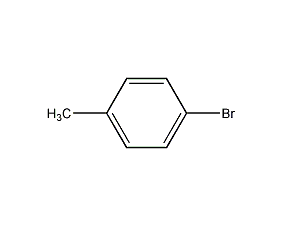
Structural formula
| Business number | 02TA |
|---|---|
| Molecular formula | C7H7Br |
| Molecular weight | 171.03 |
| label |
1-bromo-4-methylbenzene, 4-Methyl(yl)bromobenzene, p-Methyl(methyl)bromobenzene, 4-bromotoluene, p-bromotoluene, p-Methyl bromobenzene, 4-methylbromobenzene, P-bromotoluene, 1-Brom-4-methylbenzol, 1-Bromo-4-methyl-benzen, 1-Methyl-4-bromobenzene, 4-Bromo-1-methybezene, 4-Bromo-toluen, 4-Bromtoluol, 4-Methylbromobenzene, 4-Methylphenyl bromide |
Numbering system
CAS number:106-38-7
MDL number:MFCD00000109
EINECS number:203-391-8
RTECS number:XS7965600
BRN number:1903636
PubChem ID:None
Physical property data
1. Properties: White crystal.
2. Density (g/mL, 25/4℃): 1.404335
3. Relative density (20℃, 4℃): Not available Determine
4. Melting point (ºC): 28
5. Boiling point (ºC, normal pressure): 184
6. Boiling point (ºC, 5.2kPa) : Undetermined
7. Refractive index: 1.5490
8. Flash point (ºC): 85
9. Refractive index at room temperature (n20 ): 1.544330
10. Refractive index at room temperature (n25): 1.537050
11. Vapor pressure (kPa, 25ºC): Undetermined
12. Saturated vapor pressure (kPa, 60ºC): Undetermined
13. Heat of combustion (KJ /mol): Undetermined
14. Critical temperature (ºC): Undetermined
15. Critical pressure (KPa): Undetermined
16. Oil and water Log value of (octanol/water) partition coefficient: Undetermined
17. Explosion upper limit (%, V/V): Undetermined
18. Explosion lower limit (%, V /V): Undetermined
19. Solubility: Soluble in ethanol, ether and benzene, insoluble in water.
Toxicological data
1. Acute toxicity: mice intraperitoneal LD50: 248mg/kg; mammals inhalation LC50: 1300mg/m3;
Ecological data
This substance is slightly hazardous to water.
Molecular structure data
1. Molar refractive index: 38.76
2. Molar volume (cm3/mol): 121.8
3. Isotonic specific volume (90.2K ): 295.4
4. Surface tension (dyne/cm): 34.4
5. Dielectric constant:
6. Dipole moment (10-24cm3):
7. Polarizability: 15.36
Compute chemical data
1. Reference value for hydrophobic parameter calculation (XlogP): None
2. Number of hydrogen bond donors: 0
3. Number of hydrogen bond acceptors: 0
4. Number of rotatable chemical bonds: 0
5. Number of tautomers: none
6. Topological molecule polar surface area 0
7. Number of heavy atoms: 8
8. Surface charge: 0
9. Complexity: 62.8
10. Number of isotope atoms: 0
11. Determine the number of atomic stereocenters: 0
12. Uncertain number of atomic stereocenters: 0
13. Determine the number of chemical bond stereocenters: 0
14. Number of uncertain chemical bond stereocenters: 0
15. Number of covalent bond units: 1
Properties and stability
Avoid contact with strong oxidizing agents.
Storage method
Stored in a cool, ventilated warehouse. Keep away from fire and heat sources. should be kept away from oxidizer, do not store together. Equipped with the appropriate variety and quantity of fire equipment. Suitable materials should be available in the storage area to contain spills.
Synthesis method
It is obtained by diazotization and substitution of p-toluidine. First, add the sulfuric acid aqueous solution to the crushed p-toluidine while it is hot, cool it to 5°C, and slowly add the sodium nitrite aqueous solution until the starch potassium iodide test paper turns blue. Then add a small amount of urea to destroy excess sodium nitrite. Then add the synthesized cuprous bromide to hydrobromic acid, heat it to boiling, then slowly add the above-mentioned diazonium salt, and distill it until no oil is produced. Wash, dry, filter, distill under normal pressure, and collect the 183-185°C fraction to obtain the finished product. The cuprous bromide-hydrobromide solution can be prepared as follows: heat the mixture of copper sulfate, copper shavings, sodium bromide dihydrate, concentrated sulfuric acid and water to reflux for 3-4 hours until the solution turns light yellow, that is, Cuprous bromide-hydrobromide solution.
Purpose
Used in organic synthesis.

 微信扫一扫打赏
微信扫一扫打赏

